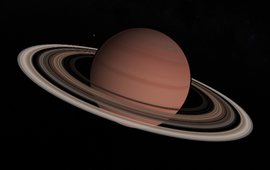| Sarnus | ||
| Sarnus as seen from orbit. | ||
| Planet of Kerbol | ||
| Orbital Characteristics | ||
| Semi-major axis | 125 798 522 368 m [Note 1] | |
| Apoapsis | 132 516 163 463 m [Note 1] | |
| Periapsis | 119 080 881 274 m [Note 1] | |
| Orbital eccentricity | 0.053 | |
| Orbital inclination | 2.02 ° | |
| Argument of periapsis | 0 ° | |
| Longitude of the ascending node | 184 ° | |
| Mean anomaly | 2.881 rad (at 0s UT) | |
| Sidereal orbital period | 258 921 266 s | |
| 11 987 d 0 h 34 m 25.6 s | ||
| Synodic orbital period | 9 542 748.6 s | |
| Orbital velocity | 2 894 - 3 220 m/s | |
| Physical Characteristics | ||
| Equatorial radius | 5 300 000 m | |
| Equatorial circumference | 33 300 882 m | |
| Surface area | 3.5298935×1014 m2 | |
| Mass | 1.2299778×1024 kg | |
| Standard gravitational parameter | 8.2089702×1013 m3/s2 | |
| Density | 1 972.3367 kg/m3 | |
| Surface gravity | 2.92 m/s2 (0.298 g) | |
| Escape velocity | 5 565.72 m/s | |
| Sidereal rotation period | 28 500.000 s | |
| 1 d 1 h 55 m 0 s | ||
| Solar day | 28 503.137 s | |
| 1 d 1 h 55 m 3.1 s | ||
| Sidereal rotational velocity | 1 168.5 m/s | |
| Synchronous orbit | 6 608.93 km | |
| Sphere of influence | 2.7401267×109 m [Note 1] | |
| Atmospheric Characteristics | ||
| Atmosphere present | ✓ Yes | |
| Atmospheric pressure | 1 418.55 kPa | |
| 14 atm | ||
| Atmospheric height | 580 000 m | |
| 1.4×10-5 atm | ||
| Temperaturemin | -176.19 °C 96.96 K | |
| Temperaturemax | -105.65 °C 167.5 K | |
| Oxygen present | × No | |
| Scientific multiplier | ||
| Surface | N/A | |
| Splashed | N/A | |
| Lower atmosphere | 13 | |
| Upper atmosphere | 10 | |
| Near space | 8 | |
| Outer space | 7 | |
| Recovery | 7 | |
|
| ||
Sarnus is a gas giant and the seventh planet of the Kerbol system. It is slightly smaller than Jool, which makes it the third largest celestial body in the system. It is the first planet added in the Outer Planets Mod and is the Saturn analog for Kerbal Space Program. The planet is an attractive target for missions, despite its distance from Kerbin (and therefore difficulty), because of its beautiful rings and its complex system of five moons: Hale, Ovok, Eeloo, Slate, and Tekto. As with Jool, it is not possible to land on Sarnus - instead, the craft is simply destroyed.
In-Game Description[]
| “ | Early astronomers believed Sarnus was in fact multiple planets, closely orbiting together. When they cleaned their telescopes, they realized that those extra planets were in fact thin rings orbiting Sarnus. Regular cleaning of telescope lenses became mandatory after that. — Kerbal Astronomical Society |
” |
Atmosphere[]
Sarnus has an extremely dense, cold atmosphere with a datum level pressure of about 14 atmospheres and a depth of 580,000 meters. Compared to the atmosphere of Kerbin, Sarnus' atmosphere has 14 times the surface pressure, and 8 times the depth. At an altitude of around 140,000 meters on Sarnus, the atmospheric pressure is the same as at sea level on Kerbin (1 atm).
Like all other atmospheres in the game, Sarnus' atmosphere fades exponentially as altitude increases. The scale height varies with altitude. The pressure-altitude profile is globally constant and independent of temperature. The following table gives the atmospheric pressure at various altitudes above the datum level.
| Altitude (m) | Pressure (Pa) | Pressure (atm) |
|---|---|---|
| 0 | 1 418 550 | 14.000 |
| 10 000 | 1 221 784 | 12.058 |
| 20 000 | 1 047 109 | 10.334 |
| 30 000 | 892 645 | 8.810 |
| 40 000 | 756 636 | 7.467 |
| 50 000 | 637 444 | 6.291 |
| 60 000 | 533 455 | 5.265 |
| 70 000 | 443 320 | 4.375 |
| 80 000 | 365 815 | 3.610 |
| 90 000 | 299 815 | 2.959 |
| 100 000 | 244 150 | 2.410 |
| 120 000 | 159 093 | 1.570 |
| 140 000 | 101 591 | 1.003 |
| 160 000 | 63 831 | 0.630 |
| 180 000 | 39 613 | 0.391 |
| 200 000 | 24 352 | 0.240 |
| 220 000 | 14 795 | 0.146 |
| 240 000 | 8 993 | 0.089 |
| 280 000 | 3 286 | 0.032 |
| 320 000 | 1 222 | 0.012 |
| 360 000 | 479.8 | 0.005 |
| 400 000 | 205.4 | 0.002 |
| 460 000 | 63.14 | 0.001 |
| 520 000 | 20.02 | 0.000 |
| 580 000 | 0 | 0.000 |
Temperatures and Atmospheric Layers[]
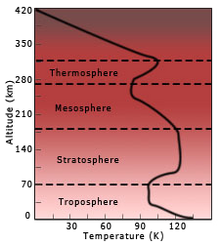
Altitude and temperature with atmospheric layers (outdated)
Air temperatures decrease as altitude increases up to an elevation of around 70 km, where a "warm pocket" is found - the temperature increases to around 123 K until an altitude of 170 km before beginning to fall again. The second warming begins around 280 km, where it increases from 85 K to 105 K at the edge of the atmosphere (304 km).
From these temperature readings, it is possible to speculate that Sarnus' atmosphere is composed of layers - a Troposphere from 0 to 70 km, a Stratosphere from 70 - 170 km, a Mesosphere from 170 - 280 km, and a Thermosphere from 280 - 450 km.
Atmospheric flight[]
Aerobraking into Sarnus orbit from a high-speed interplanetary intercept is possible but it is very difficult to achieve due to rapid and often destructive aerodynamic heating. A successful aerocapture requires a properly designed spacecraft, with a large ablator mass and a low ballistic coefficient, and precise periapsis targeting. The required periapsis altitude depends on the spacecraft's drag characteristics and its approach velocity. The margins for error are extremely small.
You could also use parachutes in Sarnus' atmosphere to slow your spacecraft down.
Composition[]
Sarnus' air has a molecular weight of 2.8 g/mol, and its adiabatic index is 0.0028. From the weight of the air, it's possible to estimate (however, unconfirmed) the composition: 75% Hydrogen, 24.3% Helium, and 0.7% Argon with traces of water ice and ammonia, among other gases.
These gases may be formed over a liquid hydrogen or metallic, molten core. From density data, it is possible to estimate the interior structure: 3,604 kilometers of Helium-saturated Hydrogen that slowly compresses into a liquid form; 1,166 kilometers of liquid, metallic hydrogen; and an iron or metallic core with a radius of 530 kilometers. Emission and Absorption spectra indicate a form of Argon may be responsible for the planet's red color, and clouds in the uppermost layers have been recorded to be composed of water and ammonia. Magnetometer readings tend to be distorted by the rings around the equatorial region, however strong radio signals are picked up from the poles which further indicates a metallic core and a large magnetosphere.
Comparison with Jool[]
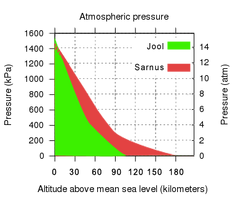
Comparison of Pressure and Altitude of Jool and Sarnus
While Sarnus and Jool are both likely composed of Hydrogen and Helium, Sarnus' atmosphere extends much farther than Jool's. This is due to the lower gravity and slightly lower pressure in Sarnus' atmosphere.
Possible Weather[]
The presence of a magnetic field, metallic core, and water clouds may indicate the possibility of widespread lighting storms. The core may be magnetically charged and the water ice crystals in the upper atmosphere would have the capability to hold an electrical charge - although lightning on Sarnus would likely be a hundred times more powerful than on Kerbin.
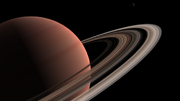
Sarnus' zones and belts as seen from orbit
Colored zones (lighter-hued) and belts (darker-hued) in the atmosphere indicate zonal winds, similar to those on Jool. From observing cloud rotation, wind speeds are estimated to vary between 470 and 530 m/s.
Ring System[]
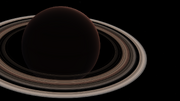
Sarnus' rings as seen from orbit
The striking rings around Sarnus' equatorial region are its most unique feature and are likely formed by dust particles from its natural satellites crashing into each other. These particles may range in size and composition, but exact sizes are unknown. It is estimated that they may be made of mostly water ice and rock. They appear to be paper-thin and extend into space quite a bit.
The innermost ring forms at around 1,500 km from the edge of Sarnus' atmosphere and extend out to 2,500 km. The absence of material between the innermost ring and Sarnus' atmospheric edge is due to residual atmospheric drag, channelling by Sarnus' magnetosphere and the Roche limit - any debris orbiting below a certain altitude will be torn apart by the tidal forces (gravity gradients).
The gap near the outermost ring is due to Sarnus' "shepherd" moon, Hale, which orbits inside the ring system and "clears the path" for itself alongside marshalling the other rings into shape. If Custom Asteroids is installed, a population of low-inclination, low-eccentricity asteroid moonlets can be found within the rings as well as more inclined and eccentric ones out beyond the rings.
Natural Satellites[]
Sarnus has five natural satellites, each with an orbit well-aligned with Sarnus orbital plane:
- Hale, a shepherd moon, is the smallest moon in the game and is located within Sarnus' rings and orbits faster than Sarnus rotates.
- Ovok, an oval moon, is orbiting just outside Sarnus' rings.
- Eeloo, the stock Pluto analog, is now orbiting Sarnus.
- Slate, a rocky moon, is a smaller version of an atmosphere-less Kerbin.
- Tekto, a rocky moon, has a low gravity with a large atmosphere and bodies of liquid.
Synchronous Orbits around any of the Sarnusian moons are impossible, as they all lie outside the Sphere of Influence of the moons, as is common with tidally locked bodies.
Biomes[]
Sarnus has a total of eight (atmosphere and space-only) biomes.
Biome list[]
 Sarnus biome map |
|
Reference frames[]
| Time warp | Minimum Altitude |
|---|---|
| 1× | Any |
| 5× | 580 000 m (above the atmosphere) |
| 10× | 580 000 m (above the atmosphere) |
| 50× | 580 000 m (above the atmosphere) |
| 100× | 580 000 m (above the atmosphere) |
| 1 000× | 795 000 m |
| 10 000× | 1 590 000 m |
| 100 000× | 3 180 000 m |

